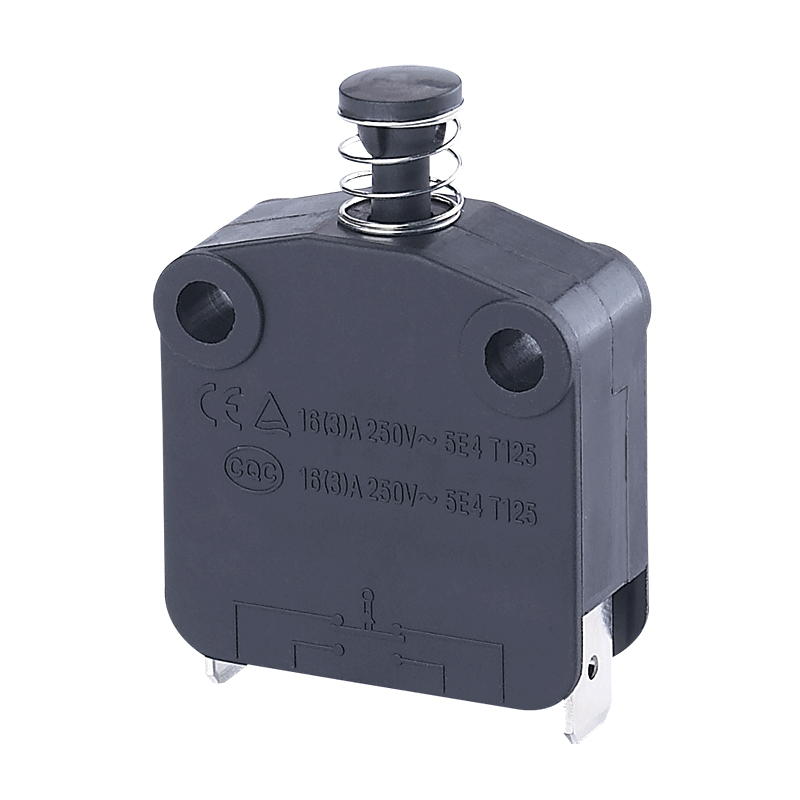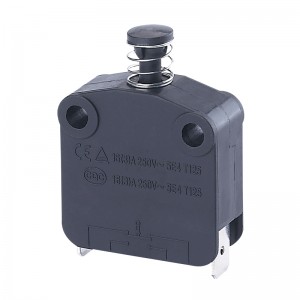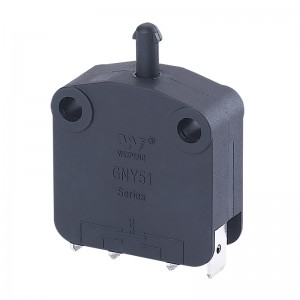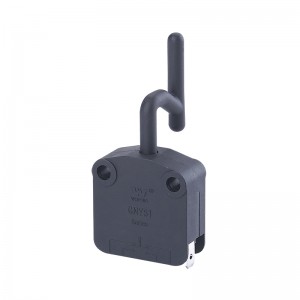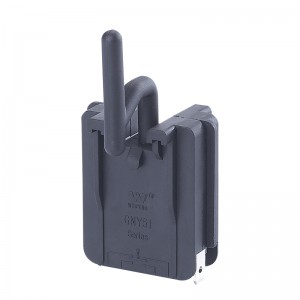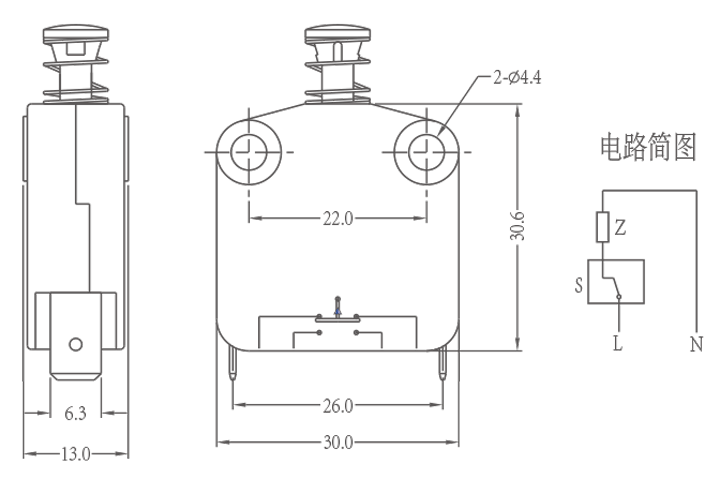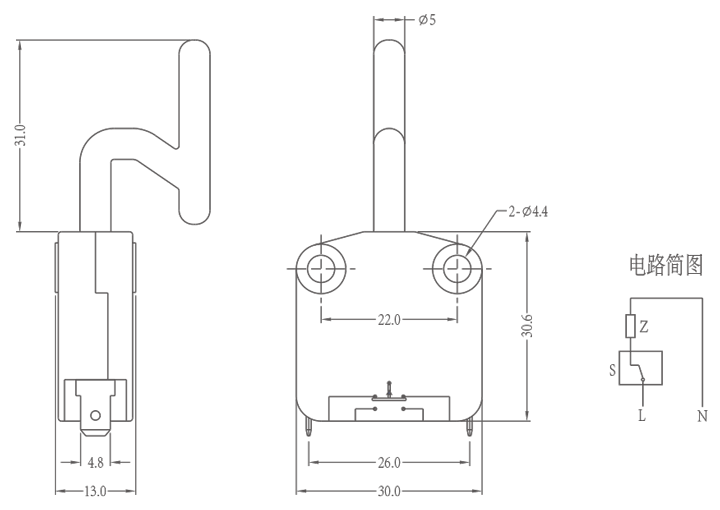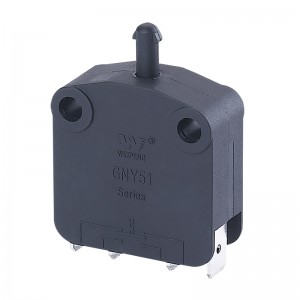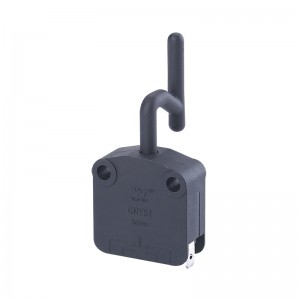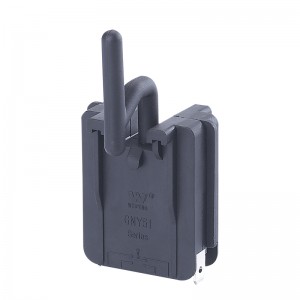GNY51-1-05
Limit Switch Stroke PUSH Slug Column Micro switches Blue 1NO 1NC better than LXW20-11
(Switch technical Characteristics):
|
(ITEM) |
(technical parameter) |
(Value) |
|
|
1 |
(Electrical Rating) | 10A 250VAC | |
|
2 |
(Contact Resistance) | ≤50mΩ( Initial value) | |
|
3 |
(Insulation Resistance) | ≥100MΩ(500VDC) | |
|
4 |
(Dielectric Voltage) | (between non-connected terminals) | 500V/0.5mA/60S |
| (between terminals and the metal frame) | 1500V/0.5mA/60S | ||
|
5 |
(Electrical Life) | ≥50000 cycles | |
|
6 |
(Mechanical Life) | ≥100000 cycles | |
|
7 |
(Operating Temperature) | 0~125℃ | |
|
8 |
(Operating Frequency) | (electrical):15 cycles(Mechanical):60 cycles | |
|
9 |
(Vibration Proof) |
(Vibration Frequency):10~55HZ;(Amplitude):1.5mm;(Three directions):1H |
|
|
10 |
(Solder Ability): (More than 80% of immersed part shall be covered with solder) | (Soldering Temperature):235±5℃(Immersing Time):2~3S | |
|
11 |
(Solder Heat Resistance) | (Dip Soldering):260±5℃ 5±1S(Manual Soldering):300±5℃ 2~3S | |
|
12 |
(Safety Approvals) |
UL、CSA、TUV、CQC、CE |
|
|
13 |
(Test Conditions) | (Ambient Temperature):20±5℃(Relative Humidity):65±5%RH(Air Pressure):86~106KPa | |
Use and maintenance
(1) Check the button frequently to remove the dirt on it. Due to the small distance between the contacts of the button, after many years of use or the seal is not good, the inflow of dust or various stages of engine oil emulsion will cause the insulation to be reduced or even a short circuit accident. In this case, insulation and cleaning must be done, and corresponding sealing measures must be taken.
(2) When the button is used in a high-temperature environment, it is easy to deform and age the plastic, causing the button to loosen, causing a short circuit between the terminal screws. According to the situation, a fastening ring can be added to tighten it for use during installation, or an insulating plastic tube can be added to the wiring screw to prevent loosening.
(3) For the button with indicator light, the bulb will heat up, and the plastic lampshade will be deformed for a long time, which will make it difficult to replace the bulb. Therefore, it is not suitable to be used in places where the power is on for a long time; if you want to use it, you can appropriately lower the bulb voltage to extend its life.
(4) If poor contact is found, the reason should be investigated: if the contact surface is damaged, it can be repaired with a fine file; if there is dirt or soot on the contact surface, it should be wiped clean with a clean cotton cloth dipped in solvent; if it is a contact spring If it fails, it should be replaced; if the contact is severely burned, the product should be replaced.
GNY51-1-01
(Switch technical Characteristics):
|
(ITEM) |
(technical parameter) |
(Value) |
|
|
1 |
(Electrical Rating) | 10A 250VAC | |
|
2 |
(Contact Resistance) | ≤50mΩ( Initial value) | |
|
3 |
(Insulation Resistance) | ≥100MΩ(500VDC) | |
|
4 |
(Dielectric Voltage) | (between non-connected terminals) | 500V/0.5mA/60S |
| (between terminals and the metal frame) | 1500V/0.5mA/60S | ||
|
5 |
(Electrical Life) | ≥50000 cycles | |
|
6 |
(Mechanical Life) | ≥100000 cycles | |
|
7 |
(Operating Temperature) | 0~125℃ | |
|
8 |
(Operating Frequency) | (electrical):15 cycles(Mechanical):60 cycles | |
|
9 |
(Vibration Proof) |
(Vibration Frequency):10~55HZ;(Amplitude):1.5mm;(Three directions):1H |
|
|
10 |
(Solder Ability): (More than 80% of immersed part shall be covered with solder) | (Soldering Temperature):235±5℃(Immersing Time):2~3S | |
|
11 |
(Solder Heat Resistance) | (Dip Soldering):260±5℃ 5±1S(Manual Soldering):300±5℃ 2~3S | |
|
12 |
(Safety Approvals) |
UL、CSA、TUV、CQC、CE |
|
|
13 |
(Test Conditions) | (Ambient Temperature):20±5℃(Relative Humidity):65±5%RH(Air Pressure):86~106KPa | |
GNY51-1-02
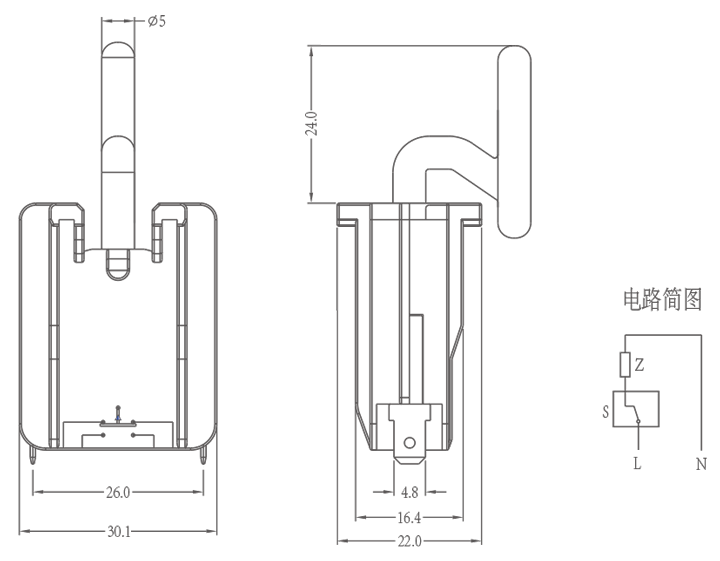
(Switch technical Characteristics):
|
(ITEM) |
(technical parameter) |
(Value) |
|
|
1 |
(Electrical Rating) | 10A 250VAC | |
|
2 |
(Contact Resistance) | ≤50mΩ( Initial value) | |
|
3 |
(Insulation Resistance) | ≥100MΩ(500VDC) | |
|
4 |
(Dielectric Voltage) | (between non-connected terminals) | 500V/0.5mA/60S |
| (between terminals and the metal frame) | 1500V/0.5mA/60S | ||
|
5 |
(Electrical Life) | ≥50000 cycles | |
|
6 |
(Mechanical Life) | ≥100000 cycles | |
|
7 |
(Operating Temperature) | 0~125℃ | |
|
8 |
(Operating Frequency) | (electrical):15 cycles(Mechanical):60 cycles | |
|
9 |
(Vibration Proof) |
(Vibration Frequency):10~55HZ;(Amplitude):1.5mm;(Three directions):1H |
|
|
10 |
(Solder Ability): (More than 80% of immersed part shall be covered with solder) | (Soldering Temperature):235±5℃(Immersing Time):2~3S | |
|
11 |
(Solder Heat Resistance) | (Dip Soldering):260±5℃ 5±1S(Manual Soldering):300±5℃ 2~3S | |
|
12 |
(Safety Approvals) |
UL、CSA、TUV、CQC、CE |
|
|
13 |
(Test Conditions) | (Ambient Temperature):20±5℃(Relative Humidity):65±5%RH(Air Pressure):86~106KPa | |
GNY51-2-200
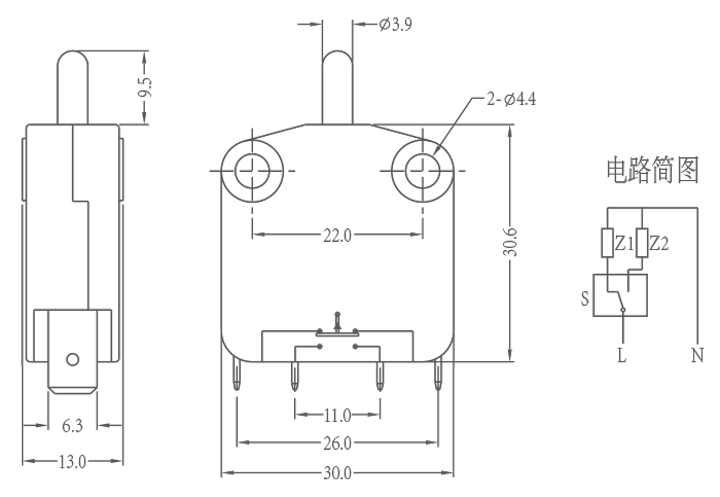
Switch technical Characteristics
GNY51
(Switch technical Characteristics):
|
(ITEM) |
(technical parameter) |
(Value) |
|
|
1 |
(Electrical Rating) | 10A 250VAC | |
|
2 |
(Contact Resistance) | ≤50mΩ( Initial value) | |
|
3 |
(Insulation Resistance) | ≥100MΩ(500VDC) | |
|
4 |
(Dielectric Voltage) | (between non-connected terminals) | 500V/0.5mA/60S |
| (between terminals and the metal frame) | 1500V/0.5mA/60S | ||
|
5 |
(Electrical Life) | ≥50000 cycles | |
|
6 |
(Mechanical Life) | ≥100000 cycles | |
|
7 |
(Operating Temperature) | 0~125℃ | |
|
8 |
(Operating Frequency) | (electrical):15 cycles(Mechanical):60 cycles | |
|
9 |
(Vibration Proof) |
(Vibration Frequency):10~55HZ; (Amplitude):1.5mm; (Three directions):1H |
|
|
10 |
(Solder Ability):(More than 80% of immersed part shall be covered with solder) | (Soldering Temperature):235±5℃(Immersing Time):2~3S | |
|
11 |
(Solder Heat Resistance) | (Dip Soldering):260±5℃ 5±1S(Manual Soldering):300±5℃ 2~3S | |
|
12 |
(Safety Approvals) |
UL、CSA、TUV、CQC、CE |
|
|
13 |
(Test Conditions) | (Ambient Temperature):20±5℃(Relative Humidity):65±5%RH
(Air Pressure):86~106KPa |
|


